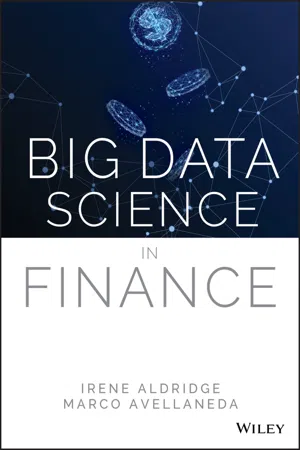
- English
- ePUB (mobile friendly)
- Available on iOS & Android
Big Data Science in Finance
About this book
Explains the mathematics, theory, and methods of Big Data as applied to finance and investing
Data science has fundamentally changed Wall Street—applied mathematics and software code are increasingly driving finance and investment-decision tools. Big Data Science in Finance examines the mathematics, theory, and practical use of the revolutionary techniques that are transforming the industry. Designed for mathematically-advanced students and discerning financial practitioners alike, this energizing book presents new, cutting-edge content based on world-class research taught in the leading Financial Mathematics and Engineering programs in the world. Marco Avellaneda, a leader in quantitative finance, and quantitative methodology author Irene Aldridge help readers harness the power of Big Data.
Comprehensive in scope, this book offers in-depth instruction on how to separate signal from noise, how to deal with missing data values, and how to utilize Big Data techniques in decision-making. Key topics include data clustering, data storage optimization, Big Data dynamics, Monte Carlo methods and their applications in Big Data analysis, and more. This valuable book:
- Provides a complete account of Big Data that includes proofs, step-by-step applications, and code samples
- Explains the difference between Principal Component Analysis (PCA) and Singular Value Decomposition (SVD)
- Covers vital topics in the field in a clear, straightforward manner
- Compares, contrasts, and discusses Big Data and Small Data
- Includes Cornell University-tested educational materials such as lesson plans, end-of-chapter questions, and downloadable lecture slides
Big Data Science in Finance: Mathematics and Applications is an important, up-to-date resource for students in economics, econometrics, finance, applied mathematics, industrial engineering, and business courses, and for investment managers, quantitative traders, risk and portfolio managers, and other financial practitioners.
Frequently asked questions
- Essential is ideal for learners and professionals who enjoy exploring a wide range of subjects. Access the Essential Library with 800,000+ trusted titles and best-sellers across business, personal growth, and the humanities. Includes unlimited reading time and Standard Read Aloud voice.
- Complete: Perfect for advanced learners and researchers needing full, unrestricted access. Unlock 1.4M+ books across hundreds of subjects, including academic and specialized titles. The Complete Plan also includes advanced features like Premium Read Aloud and Research Assistant.
Please note we cannot support devices running on iOS 13 and Android 7 or earlier. Learn more about using the app.
Information
Chapter 1
Why Big Data?
Introduction
- Data scouts or data managers, whose job already is and will continue to be to seek the new data sources capable of delivering uncorrelated sources of revenues for the portfolio managers.
- Data scientists, whose job will expand into creating meaningful models capable of grabbing the data under consideration and converting them into portfolio management signals.
- Specialists, who will possess a deep understanding of the data in hand, say, what the particular shade of the wheat fields displayed in the satellite imagery means for the crop production and respective futures prices, or what the market microstructure patterns indicate about the health of the market.
Table of contents
- Cover
- Table of Contents
- Title Page
- Copyright
- Preface
- Chapter 1: Why Big Data?
- Chapter 2: Neural Networks in Finance
- Chapter 3: Supervised Learning
- Chapter 4: Modeling Human Behavior with Semi-Supervised Learning
- Chapter 5: Letting the Data Speak with Unsupervised Learning
- Chapter 6: Big Data Factor Models
- Chapter 7: Data as a Signal versus Noise
- Chapter 8: Applications: Unsupervised Learning in Option Pricing and Stochastic Modeling
- Chapter 9: Data Clustering
- Index
- End User License Agreement